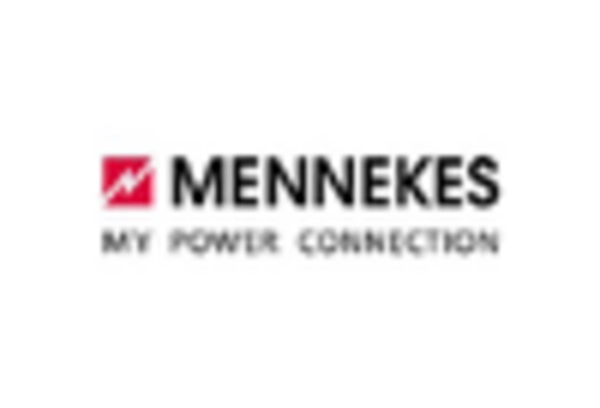Increased Safety Regulations
The implementation of stringent safety regulations across various industries is a crucial driver for the Industrial Plugs & Sockets Market. Governments and regulatory bodies are increasingly mandating compliance with safety standards to prevent electrical hazards. This regulatory environment compels manufacturers to invest in high-quality industrial plugs and sockets that meet these safety requirements. For instance, the introduction of new standards in sectors such as construction and manufacturing has led to a heightened demand for reliable electrical connections. As a result, the Industrial Plugs & Sockets Market is likely to see a rise in demand for products that not only comply with safety regulations but also enhance operational safety in industrial settings.
Rising Industrial Automation
The increasing trend towards industrial automation is a pivotal driver for the Industrial Plugs & Sockets Market. As manufacturers seek to enhance efficiency and reduce labor costs, the demand for automated systems is surging. This shift necessitates reliable and robust electrical connections, which are provided by industrial plugs and sockets. According to recent data, the automation sector is projected to grow at a compound annual growth rate of over 9% in the coming years. This growth directly correlates with the rising need for high-quality industrial plugs and sockets that can withstand the rigors of automated environments. Consequently, the Industrial Plugs & Sockets Market is likely to experience substantial growth as industries increasingly adopt automation technologies.
Expansion of Renewable Energy Sources
The global transition towards renewable energy sources is significantly influencing the Industrial Plugs & Sockets Market. As countries invest in solar, wind, and other renewable energy infrastructures, the demand for specialized electrical connections is escalating. Industrial plugs and sockets are essential for connecting various components of renewable energy systems, ensuring safety and efficiency. Recent statistics indicate that investments in renewable energy are expected to exceed $2 trillion annually by 2030. This surge in investment creates a robust market for industrial plugs and sockets, as they are integral to the installation and maintenance of renewable energy systems. Thus, the Industrial Plugs & Sockets Market stands to benefit from this ongoing energy transition.
Technological Innovations in Electrical Components
Technological innovations in electrical components are reshaping the Industrial Plugs & Sockets Market. Advancements in materials and design are leading to the development of more efficient and durable plugs and sockets. Innovations such as smart plugs, which offer enhanced connectivity and monitoring capabilities, are gaining traction in various industrial applications. The market for smart electrical components is projected to grow significantly, with estimates suggesting a compound annual growth rate of over 10% in the next few years. This trend indicates a shift towards more sophisticated electrical solutions, thereby driving the demand for advanced industrial plugs and sockets. Consequently, the Industrial Plugs & Sockets Market is poised for growth as it adapts to these technological advancements.
Growth in Construction and Infrastructure Development
The ongoing growth in construction and infrastructure development is a significant driver for the Industrial Plugs & Sockets Market. As urbanization accelerates, there is a corresponding increase in the demand for electrical installations in new buildings and infrastructure projects. Industrial plugs and sockets are essential components in these installations, providing safe and efficient electrical connections. Recent data suggests that the construction industry is expected to grow at a rate of approximately 5% annually, driven by urban development and infrastructure projects. This growth presents a substantial opportunity for the Industrial Plugs & Sockets Market, as the need for reliable electrical connections in construction projects continues to rise.

















Leave a Comment